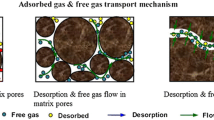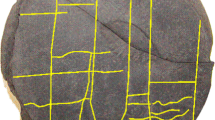Abstract
Multiple types of pores are present in shale gas reservoirs, including organic pores of nano scale, non-organic pores, natural and hydraulic fractures. Gas flow in different types of pores is controlled by different mechanisms, and Darcy’s law is not able to describe all these processes adequately. This paper presents a “quadruple-porosity” model and corresponding analytical solutions to describe the different permeable media and simulate transient production behavior of multiple-fractured horizontal wells in shale gas reservoirs. Dimensionless transient production decline curves are plotted, and characteristic bilinear flow and linear flow periods are identified based on the analysis of type curves. Sensitivity analysis of transient production dynamics suggests that desorption of absorbed gas, Knudsen diffusive flow, gas slippage and parameters related to hydraulic fractures have significant influence on the production dynamics of a multiple-fractured horizontal well in shale gas reservoirs. The model provides insights into multiple shale gas flow mechanisms and production prediction of shale gas reservoirs.












Similar content being viewed by others
Abbreviations
- B g :
-
Volume factor of shale gas, m3/sm3
- c g :
-
Gas compressibility, Pa−1
- D :
-
Knudsen diffusion coefficient, m2/s
- L f :
-
Thickness of single matrix slab, m
- L F :
-
Half-distance between hydraulic fractures, m
- F :
-
Gas slippage factor, dimensionless
- k :
-
Permeability, m2;
- M :
-
Molecular weight of gas, kg/kmol
- m :
-
Pseudo-pressure, Pa/s
- N A :
-
Avogadro’s constant, 6.02221415 × 1026 kmol−1
- p :
-
Pressure, Pa
- p L :
-
Langmuir pressure, Pa
- q Fsc :
-
Hydraulic fracture production rate under standard condition, m3/s
- s :
-
Laplace transformation parameter
- S o :
-
Total number of surface sites for gas adsorption
- SSA:
-
Specific surface area, 1/m
- t :
-
Time, s
- u :
-
Gas flow velocity, m/s
- V L :
-
Langmuir volume, m3/kg
- w F :
-
Hydraulic fracture width, m
- x F :
-
Half-length of hydraulic fracture, m
- Z :
-
Z-factor of real gas, dimensionless
- β :
-
Apparent permeability coefficient, dimensionless
- θ :
-
Proportion of pore surface occupied by gas molecules, fraction
- ρ g :
-
Gas density, kg/m3
- ρ bi :
-
Bulk density of shales, kg/m3
- μ g :
-
Gas viscosity, Pa·s
- \(\phi\) :
-
Porosity, fraction
- \(\omega\) :
-
Storativity ratio, dimensionless
- \(\lambda\) :
-
Interporosity flow coefficient, m2/s
- D:
-
Dimensionless
- f:
-
Natural fracture system
- F:
-
Hydraulic fracture system
- i:
-
Initial condition
- k:
-
Organic system
- m:
-
Non-organic system
- sc:
-
Standard condition
- t:
-
Total
- L:
-
Langmuir’s constant
References
Al-Hussainy R, Ramey HJ, Crawford PB (1966) The flow of real gases through porous media. JPT 18(5):624–636
Bello RO, Wattenbarger RA (2010a) Modeling and analysis of shale gas production with a skin effect. J Can Pet Technol 49(12):37–48
Bello RO, Wattenbarger RA (2010) Multi-stage hydraulically fractured horizontal shale gas well rate transient analysis. SPE Paper 126754 presented at the SPE North Africa Technical Conference and Exhibition. Cairo
Brown GP, Dinardo A, Cheng GK, Sherwood TK (1946) The flow of gases in pipes at low pressures. J Appl Phys 17:802–813
Brown M, Ozkan E, Raghavan R, Kazemi H (2009) Practical solutions for pressure transient responses of fractured horizontal wells in unconventional reservoirs. SPE Reservoir Eval Eng 14(6):663–676
Gou Y, Zhou L, Zhao X, Hou ZM, Were P (2015) Numerical study on hydraulic fracturing in different types of georeservoirs with consideration of H2M-coupled leak-off effects. Environ Earth Sci. doi:10.1007/s12665-015-4112-5
Haghshenas B, Chen S, Clarkson CR (2013) Multi-porosity multi-permeability models for shale gas reservoirs. SPE Paper 167220 presented at the Unconventional Resources Conference. Calgary
Hill B, Nelson CR (2000) Gas productive fractured shales: an overview and update. Gas TIP 6:4–13
Javadpour F (2009) Nanopores and apparent permeability of gas flow in mudrocks (Shale and siltstone). J Can Pet Technol 48(8):16–21
Javadpour F, Fisher D, Unsworth M (2007) Nanoscale gas flow in shale gas sediments. J Can Pet Technol 46(10):55–61
Kissinger A, Helmig R, Ebigbo A, Class H, Lange T, Sauter M, Heitfeld M, Klunker J, Jahnke W (2013) Hydraulic fracturing in unconventional gas reservoirs: risks in the geological system part 2. Environ Earth Sci 70:3855–3873. doi:10.1007/s12665-013-2578-6
Lange T, Sauter M, Heitfeld M, Schetelig K, Brosig K, Jahnke W, Kissinger A, Helmig R, Ebigbo A, Class H (2013) Hydraulic fracturing in unconventional gas reservoirs: risks in the geological system part 1. Environ Earth Sci 70:3839–3853. doi:10.1007/s12665-013-2803-3
Medeiors F, Ozkan E, Kazemi H (2008) Productivity and drainage area of fractured horizontal wells in tight gas reservoirs. SPE Reservoir Eval Eng 11(5):902–911
Nie HK, Zhang JC (2010) Shale gas reservoir distribution geological law, characteristics and suggestions. J Cent South Univers 41(2):700–707
Reed RM, John A, Katherine G (2007) Nanopores in the Mississippian Barnett shale: Distribution, morphology, and possible genesis. GAS Annual Meeting & Exposition. Denver
Shabro V, Torres-Verdin C, Javadpour F (2011) Numerical simulation of shale-gas production: from pore-scale modeling of slip-flow, Knudsen diffusion and Langmuir desorption to reservoir modeling of compressible fluid. SPE Paper 144355 presented at the SPE North American Unconventional Conference and Exhibition. Woodlands
Stalgorova E, Mattar L (2012) Practical analytical model to simulate production of horizontal wells with branch fractures. SPE Paper 162515 presented at the SPE Canadian Unconventional Resources Conference, Calgary. Alberta
Stalgorova E, Mattar L (2013) Analytical model for unconventional multifractured composite systems. SPE Reservoir Eval Eng 16(3):246–256
Stehfest H (1970) Numerical inversion of Laplace transforms. Comm ACM 13:47–49
Swami V, Settari A (2012) A pore scale flow model for shale gas reservoir. SPE Paper 155756 presented at the Americas Unconventional Resources Conference. Pittsburgh, Pennsylvania
Van-Everdingen AF, Hurst W (1949) The application of the Laplace transformation to flow problem in reservoirs. J Petrol Technol 1(12):305–324
Wang HT (2014) Performance of multiple fractured horizontal wells in shale gas reservoirs with consideration of multiple mechanisms. J Hydrol 510:299–312
Zeng FH, Zhao G (2007) Gas well production analysis with non-Darcy flow and real-gas PVT behavior. J Petrol Sci Eng 59:169–182
Zeng FH, Zhao G (2010) The optimal hydraulic fracture geometry under non-Darcy flow effects. J Petrol Sci Eng 72:143–157
Zhao JZ, Liu CY, Yang H, Li YM (2015) Strategic questions about China’s shale gas development. Environ Earth Sci. doi:10.1007/s12665-015-4092-5
Acknowledgments
The authors are grateful for the support provided by the National Science Fund for Distinguished Young Scholars of China (Grant No. 51125019) and the National Natural Science Foundation of China (Grant No. 51404206; 51304165). The authors would also like to thank the reviewers and editors for their constructive suggestions, which helped in improving the quality of the manuscript.
Author information
Authors and Affiliations
Corresponding authors
Appendices
Appendix A: non-organic system solution
The Laplace transformation of the dimensionless governing equation of non-organic system, i.e., Eq. (27), yields the following equation in the Laplace domain:
Corresponding dimensionless boundary conditions, i.e., Eqs. (29) and (30), can also be transformed into the Laplace domain:
Equation (49) together with Eqs. (50) and (51) compose a boundary value problem, and the general solution of Eq.(49) can be obtained as follows:
where A 1 and B 1 are coefficients which can be determined with corresponding boundary conditions of non-organic system.
Taking derivative of Eq. (52) with respect to z D and substituting it into Eq. (50), the coefficient B 1 can be obtained as follows:
Using the boundary condition given by Eq. (51), the coefficient A 1 can be obtained as follows:
The final solution of the dimensionless mathematical model for non-organic system thus can be obtained by substituting Eqs. (53) and (54) into Eq. (52):
Appendix B: organic system solution
The Laplace transformation of the dimensionless governing equation of organic system, i.e., Eq. (31), yields the following equation in the Laplace domain:
Corresponding dimensionless boundary conditions, i.e., Eqs. (33) and (34), can also be transformed into the Laplace domain:
Equation (56) together with Eqs. (57) and (58) also compose a boundary value problem, and the general solution of Eq. (56) can be obtained as follows:
where A 2 and B 2 are coefficients which can be determined with corresponding boundary conditions of organic system.
Taking derivative of Eq. (59) with respect to z D and substituting it into Eq. (57), the coefficient B 2 can be obtained as follows:
With the boundary condition given by Eq. (58), the coefficient A 2 can be obtained as follows:
The final solution of the dimensionless mathematical model for organic system thus can be obtained by substituting Eqs. (60) and (61) into Eq. (59):
Appendix C: natural fracture system solution
The Laplace transformation of the dimensionless governing equation of natural fracture system, i.e., Eq. (35), yields the following equation in the Laplace domain:
Taking derivatives of Eqs. (55) and (62) with respect to z D and setting z D equal to 1, we can obtain the following equations:
Substitution of Eqs. (64) and (65) into Eq. (63) yields:
where \(f_{1} \left( s \right) = \omega_{\text{f}} + \frac{{\lambda_{\text{mf}} \beta_{\text{m}} }}{3s}\sqrt {\frac{{3s\omega_{\text{m}} }}{{\lambda_{\text{mf}} \beta_{\text{m}} }}} \tanh \left( {\sqrt {\frac{{3s\omega_{\text{m}} }}{{\lambda_{\text{mf}} \beta_{\text{m}} }}} } \right) + \frac{{\lambda_{\text{kf}} \beta_{\text{k}} }}{3s}\sqrt {\frac{{3s\omega_{\text{k}} \left( {1 + \sigma_{\text{k}} } \right)}}{{\lambda_{\text{kf}} \beta_{\text{k}} }}} \tanh \left( {\sqrt {\frac{{3s\omega_{\text{k}} \left( {1 + \sigma_{\text{k}} } \right)}}{{\lambda_{\text{kf}} \beta_{\text{k}} }}} } \right)\).
Corresponding dimensionless boundary conditions, i.e., Eqs. (37) and (38), can also be transformed into the Laplace domain:
The general solution of Eq. (66) is:
where A 3 and B 3 are coefficients which can be later determined with corresponding boundary conditions of natural fracture system.
Similarly, taking derivative of Eq. (69) with respect to y D and substituting it into Eq. (67), we can obtain the following equation:
Substitution of Eq. (69) into the Eq. (68) yields:
The coefficients A 3 and B 3 can be determined by solving Eqs. (70) and (71) simultaneously:
The final solution of the dimensionless mathematical model for natural fracture system thus can be obtained by substituting Eqs. (72) and (73) into Eq. (69):
Appendix D: hydraulic fracture system solution
The Laplace transformation of the dimensionless governing equation of hydraulic fracture system, i.e., Eq. (39), yields the following equation in the Laplace domain:
Taking derivative of Eq. (74) with respect to y D and setting y D equal to w FD/2, we can obtain the following equations:
Substitution of Eq. (76) into Eq. (75) yields:
where \(f_{2} \left( s \right) = \left\{ {\frac{{\omega_{f} }}{{\eta_{D} }} + \frac{{2\sqrt {sf_{1} \left( s \right)} }}{{sC_{FD} }}\tanh \left[ {\left( {\frac{{L_{FD} - w_{FD} }}{2}} \right)\sqrt {sf_{1} \left( s \right)} } \right]} \right\}\).
Corresponding dimensionless boundary conditions, i.e., Eqs. (41) and (42), can also be transformed into the Laplace domain:
The general solution of Eq. (77) can be obtained as follows:
where A 4 and B 4 are coefficients which can be later determined with corresponding boundary conditions of hydraulic fracture system.
Taking derivative of Eq. (80) with respect to x D, and we can obtain:
Substitution of Eq. (81) into Eq. (78) yields:
Thus we can get:
Substitution of Eqs. (81) and (83) into Eq. (79) yields:
Thus we can get:
Then the dimensionless pressure response for hydraulic fracture system is obtained to be:
After some mathematical manipulations, Eq. (86) can be rewritten as:
Rights and permissions
About this article
Cite this article
Guo, J., Zhang, L. & Zhu, Q. A quadruple-porosity model for transient production analysis of multiple-fractured horizontal wells in shale gas reservoirs. Environ Earth Sci 73, 5917–5931 (2015). https://doi.org/10.1007/s12665-015-4368-9
Received:
Accepted:
Published:
Issue Date:
DOI: https://doi.org/10.1007/s12665-015-4368-9




